JUNCKERS SINGLE STAVE BLOCKS
LAYING INSTRUCTIONS
C 9.0
C 9.0
Junckers system solutions
Junckers system solutions for single stave blocks
In order to make it simple for the contractor and floorlayer and at the same time create a classic, solid wooden floor, Junckers offers complete system solutions for the installation of single stave blocks.
The products which are part of the installation process are listed below:
Before and during laying
Junckers Moisture Barrier
1-component moisture barrier, which can be used against residual moisture in concrete sub floors. Used where moisture content exceeds the recommended limits.

Junckers Parquet Glue
For Junckers Glue Down floor system.

Finishing treatment
Junckers PreLak water-based
Fast drying primer to be used if you want a light surface

Junckers ProSeal oil-based
Slow drying primer to be used if you want to enhance the depth of the colour of the wood

Junckers ProFinish water-based
Is used for lacquering of floors in residential and other low-traffic areas.

Junckers HP COMMERCIAL
For lacquering of floors in high traffic areas.

Junckers Rustic Oil clear or colour
Is chosen when you want to enhance the depth of the colour of the wood or if you want a coloured finish.

Junckers Professional Hardwax Oil
Is chosen when you want a floor with a deep rich colour and a saturated finish.

GENERAL INFORMATION
Stave parquet is a traditional type of wooden flooring which has been used for centuries. Different traditions for laying and treatment of the floors have been established by craftsmen in different countries and Junckers has great respect for these traditions. Therefore, this document is to be seen as Junckers’ guidance on laying, finishing treatment and maintenance of single stave blocks.
Junckers parquet staves have gone through a thorough quality control process at the factory – it is however, important also to check for errors and defects before and during the installation.
The staves are delivered untreated and require sanding and surface treatment after installation (see the section about surface treatment). If the staves are glued down, sanding must be carried out no earlier than 24 hours after gluing.
Depending on the parquet pattern, the staves are supplied in parquet bundles marked with right and left hand staves (see figure below). It is important to keep the staves separate until installation. For example, right and left hand staves are used in the herringbone pattern.
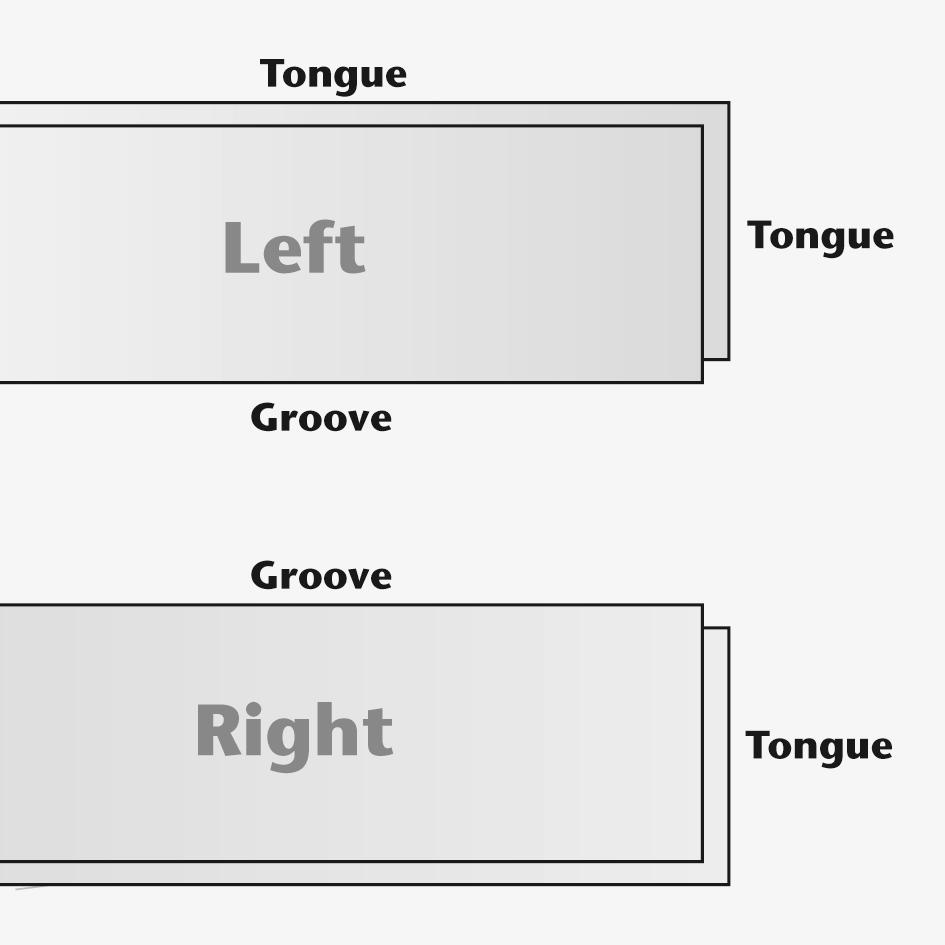
Stave dimensions
15 mm short stave: 58.3 x 467.6 mm single stave
22 mm short stave: 58.3 x 467.6 mm single stave
15 mm long stave 62.1 x 623.5 mm single stave
22 mm long stave 62.1 x 623.5 mm single stave
Junckers single stave blocks are used for the following floor patterns:
Single Herringbone
Uses: Right and Left hand staves in all dimensions.
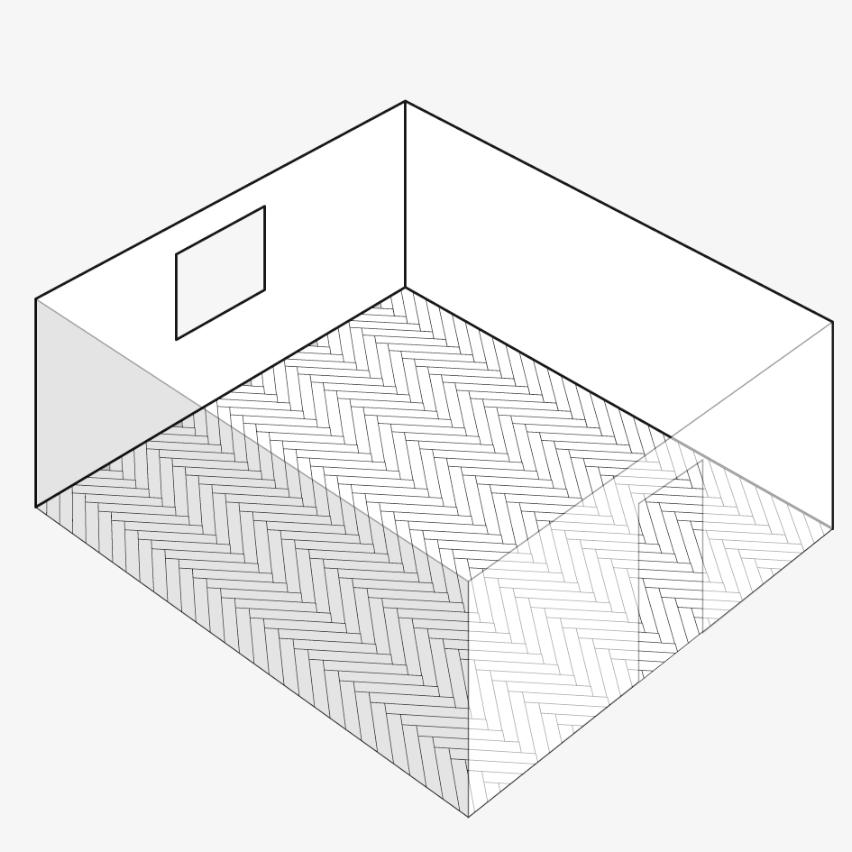
Ladder
Uses: Right hand staves in all dimensions.
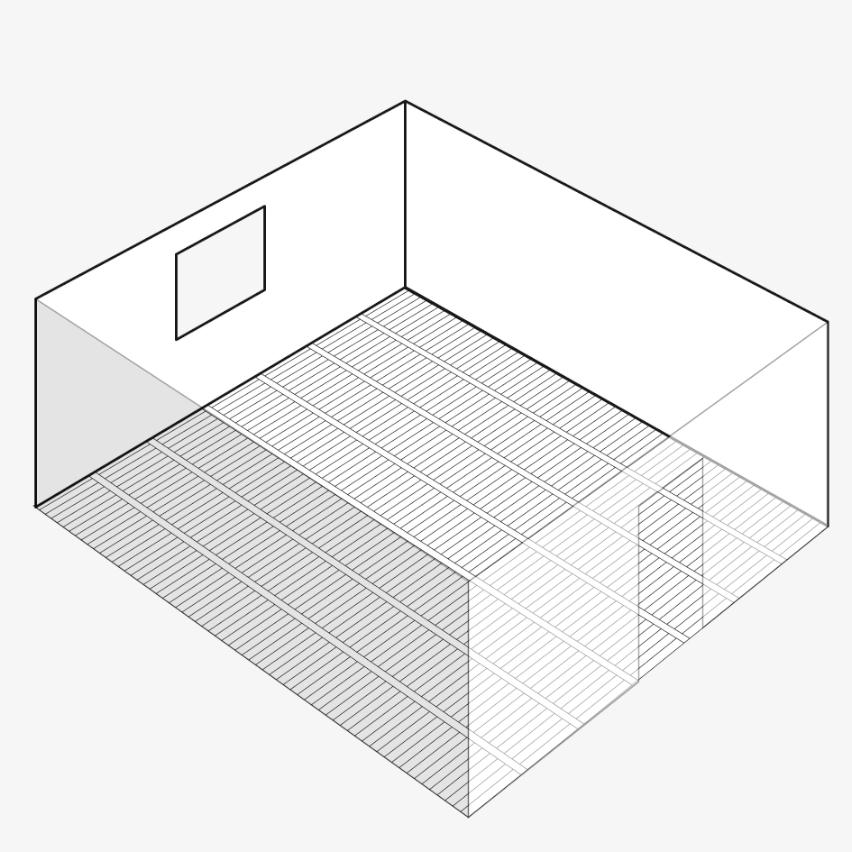
Square Basket
Uses:
Right and Left hand staves in all dimensions (shown with short length staves).
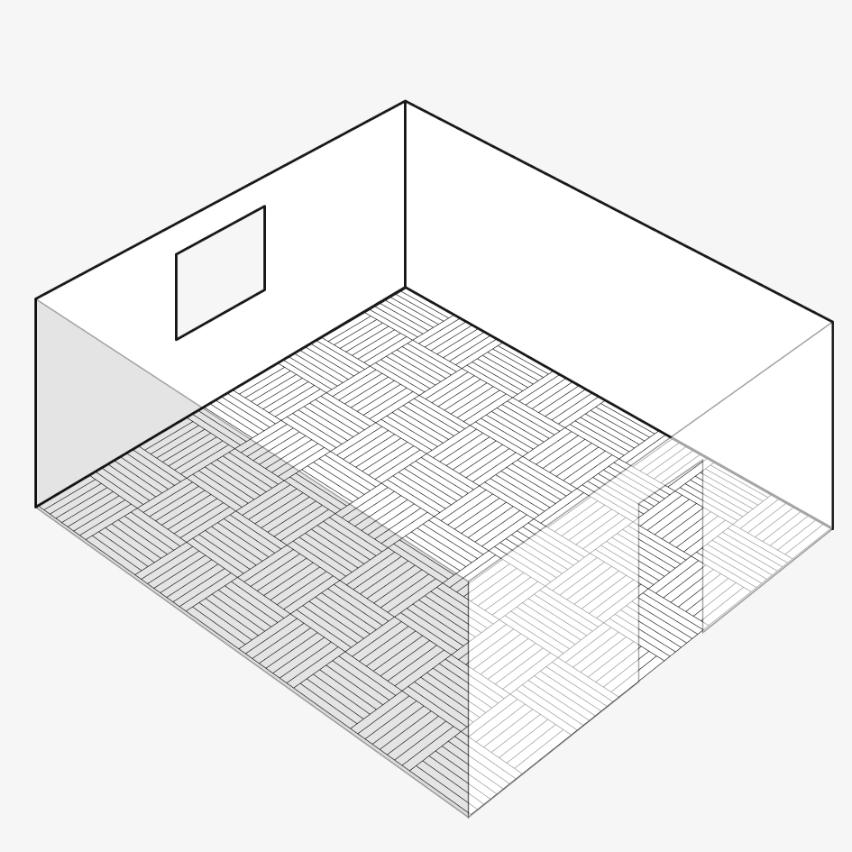
English
Uses: Right and Left hand staves, size 22 x 58,3 x 467,6, and pattern-blocks in 88 x 88 mm

Four Strip Herringbone
Uses: Right and Left hand staves in all dimensions (shown with short length staves).

Before delivery
Before the materials are delivered, the relative humidity in the building must be within the range expected when in use, eg 35-65%, and the temperature must be approximately 20°C.
If the above temperature and relative humidity levels cannot be met, we ask you to contact Junckers before delivery. The staves should be delivered 1 or 2 days before installation is due to begin. Parquet staves for patterns such as herringbone, square etc. must not be unwrapped until immediately before laying as it is important that they are as close to the manufacturing condition as possible.
ENVIROMENTAL CONDITIONS
In order to keep moisture related movement of the floor to a minimum, the humidity should be stable for extended periods of time and the humidity range, i.e. the difference between the lowest and the highest relative humidity during the year, should not exceed 25 to 30 percentage points. Examples of humidity ranges are: 25-50%, 35-65% RH. The instructions below are based on the range 35-65% RH.
If site conditions should vary from the above, it is advisable to contact Junckers Technical Service Department.
BEFORE LAYING THE FLOOR
The building must be weathertight. The heating system must be installed and tested and should be in operation during the heating season. Cast concrete elements, screeding and other wet trades which can contribute moisture to the building, eg tiling, plastering and priming of paintwork, must also be completed.
UNDERFLOOR HEATING
Junckers single stave blocks can be used in connection with underfloor heating systems which will provide an even temperature distribution. The temperature on the surface of the parquet staves should not exceed 27°C. The underfloor heating must be switched off for 2 days before installation is started; after installation it is raised slowly by maximum 5ºC every second day. However, the working temperature for the glue must be minimum 15°C. With underfloor heating the gaps which typically appear in a wooden floor during the heating season will be larger than with heating from radiators. When laying stave parquet direct on concrete with underfloor heating we recommend 22 mm stave thickness.
INSTALLATION
The staves can be screwed, nailed or glued to a subfloor of plywood / existing wooden floor or screwed or glued to a chipboard base. Furthermore, they can be glued down to a concrete or screeded subfloor. The moisture content of a wood based subfloor must not exceed 12% and for concrete/screeded subfloors it must not exceed 75% RH. When screwing or nailing, a 500 g/m² floor cardboard is to be inserted between the wooden subfloor and the staves in order to minimize creaking between the staves and the subfloor. Each stave is fixed by secret nailing/screwing at a 45º angle with at least 2 nails or screws per stave.
Fixing:
15 mm staves: Junckers J-nails or 45 mm T-nails for nail gun. For screwing use 35 mm Monta-Flex screws. For gluing use Junckers Parquet Glue.
22 mm staves: Junckers J-nails or 65 mm T-nails for nail gun. For screwing use 45 mm Monta-Flex screws. For gluing use Junckers Parquet Glue.
For screw fixing it may be necessary to pre-drill (use a drill with a slightly smaller diameter than the screw).
Solid parquet staves from Junckers must NOT be glued in tongue and groove. However, staves which are shorter than 100 mm may occasionally be glued in the heading joints at walls or borders and in the tongue and groove at the last row of staves at the wall.
Existing wooden floor
The staves should be laid so that their longitudinal direction is perpendicular to the existing floor boards. In order to achieve the correct surface tolerance, the subfloor can be levelled by planing, filling or by fixing minimum 15mm thick plywood to the base. If plywood is used, the original laying direction can be used. It is important that the existing wooden floor has been properly fixed without loose boards or protruding fastenings.
Plywood floor
Plywood sub floors must be a minimum 18mm thickness with battens at maximum 520mm centres. If plywood is being fixed to an existing timber base, 12mm thickness may be used. Tongue and grooved jointed plywood must be glued together in accordance with the manufacturer’s instructions.
Chipboard floor
Flooring grade chipboard 22 mm can be used and laid on battens with maximum support centres of 600 mm. If the chipboard is laid on an existing floor, it must be approved chipboard of minimum 16 mm. The boards must be fitted according to the manufacturer’s directions and must be glued in the tongue and groove joints.
Concrete/screed
Before the floor installation is started, you must make sure that the relative humidity in the concrete or screed does not exceed 75% RH. With underfloor heating the relative humidity in the concrete or screed must not exceed 65% RH and, at the same time, the floor heating system must be switched off while the installation is carried out. If the relative humidity in the concrete or screed is higher than stated above, the floor installation must be postponed or a high performance damp proofing material may be used. Junckers liquid surface applied moisture membrane may be used on sub floors with a relative humidity up to 95% RH Contact Junckers Technical Service Department.
Glue Down method
For gluing the floor use Junckers Parquet Glue. The glue is applied using the Junckers notched Glue Spatula leaving a thin glue coat on the floor between the glue tracks. Hold the spatula at an angle of 45° and with the side marked ”2” turned downwards. Use approximately 0.5 litre per m², depending on the absorption capacity, structure and flatness of the subfloor. Only apply sufficient glue that the laying of the staves can be finished within 20 minutes.
There are some important points to consider when fitting block floors.
The first row of staves is used to set out the rest of the floor and can be fitted with our normal adhesive but it must be thoroughly set before the main field of the floor is installed.
Before laying the staves, any subfloors must be levelled to a tolerance of no more than 3 mm gap showing under a 2m straight edge. The surface must be smooth with no roughness. Local irregularities must be levelled.
All subfloors must be completely cleaned from grease and dirt before laying the staves.
If the floor is to be finished by a border, see the section on herringbone pattern.
For some patterns, eg. Ladder pattern, where staves are laid in parallel over large areas, it may be necessary to include some expansion allowances within the floor between staves. The amount of expansion allowance to be left is described as the “10 board measure” which is the measurement across 10 staves including expansion gaps.
The 10-board measurement for Junckers stave parquet laid in a ladder pattern or similar (at RH between 35% and 65% - temperature between 18 C-22°C):
Short staves, 58.3 mm: 584.0 – 584.5 mm
Long staves, 62.2 mm: 623.5 – 624.0 mm
Distance to walls and expansion gaps
Depending on the size of the room, an expansion gap of 12-15 mm at walls and fixed installations should be left in order to allow the natural movement of the floor to take place. Junckers can supply matching skirting, quadrant or scotia mouldings to cover this gap. Alternatively the gap can be filled with Junckers cork or rubber strip.
We recommend that expansion gaps are established in the following cases: Where there are large variations in temperature and humidity, with particularly large floor areas, or where the floor is naturally divided by doors etc. Furthermore, any structural movement joints in the sub floor of the building must be taken up through the wooden floor if this is glued down to the subfloor.
HERRINGBONE PATTERN
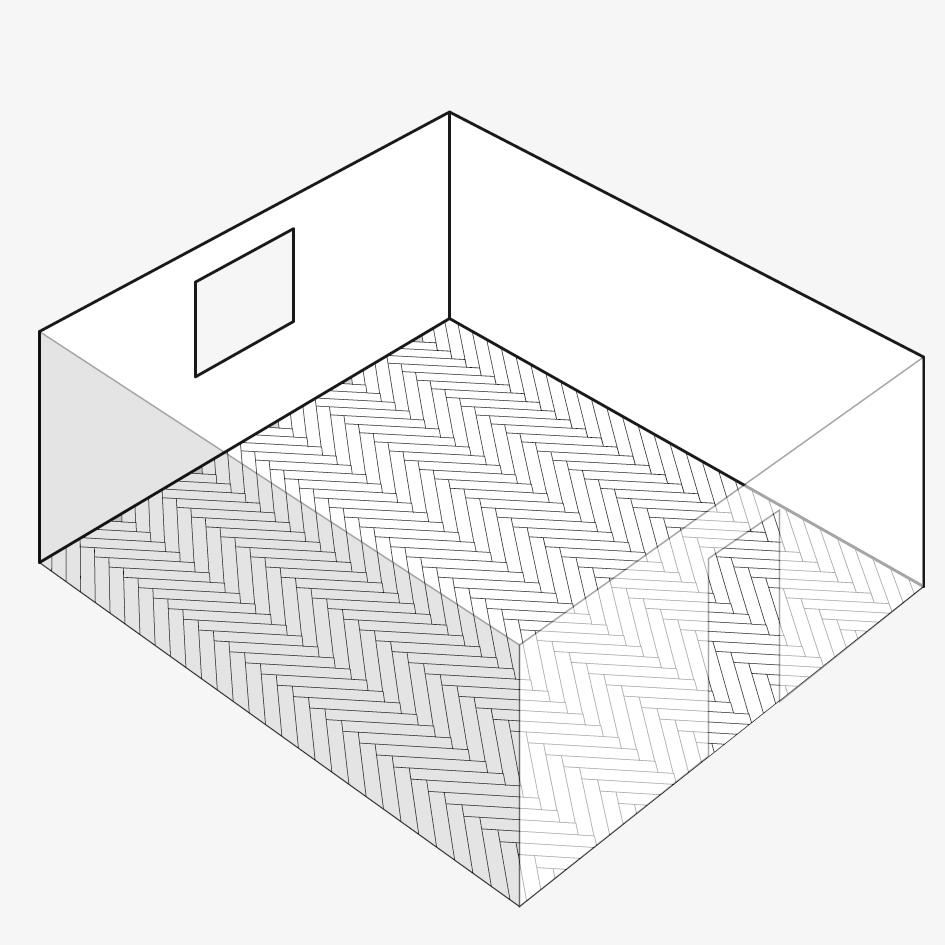
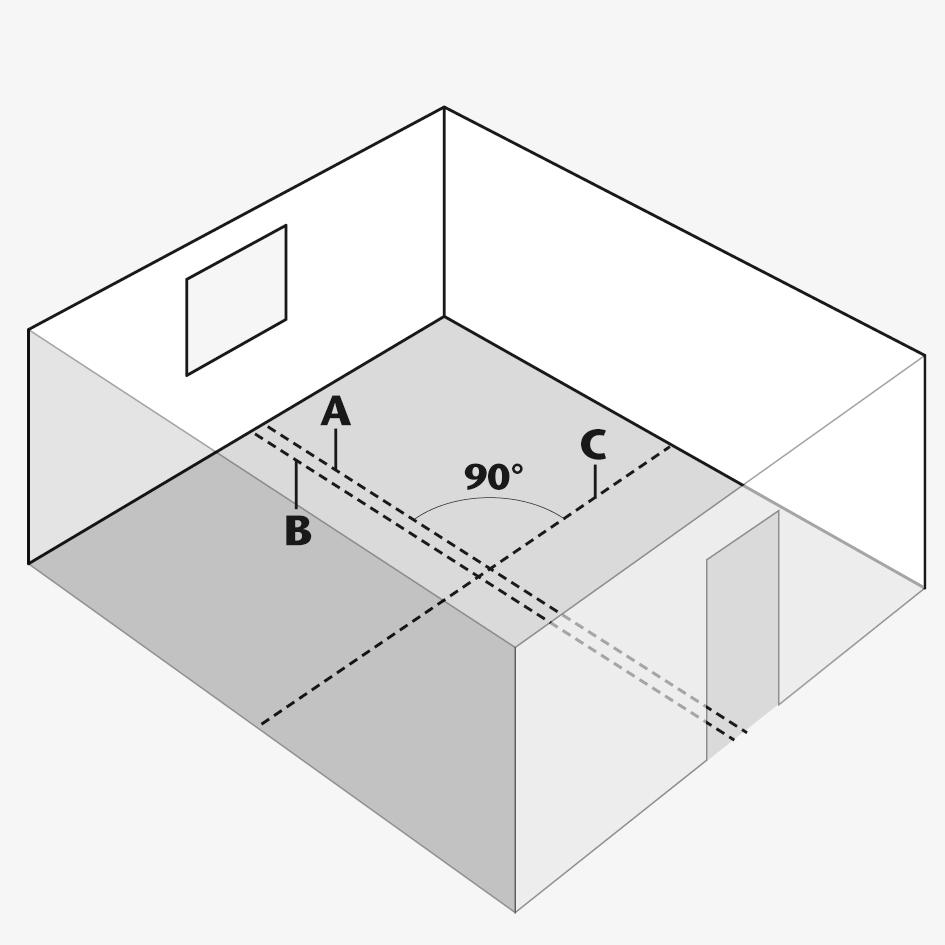
The two centre lines in the room (lines A and C) are marked by a chalk line or string at an angle of 90° to each other.
A working line is drawn with a string or chalk line (line B) 1/3 of the stave width to the left of the centre line.

The corners of the staves must be in line with the working line (line B).
In order to regulate the laying direction of the starting row, the centre line (line C) can be used as regulating line for the corners on the right and left staves, respectively (see figure).
Left staves are laid to the right and right staves are laid to the left.

During the entire laying it is very important to make sure that the staves are at an angle of 90°.
Particularly at the starting rows (the two first rows of staves which are laid down through the room) it is important that these rows are exactly at an angle of 90°.
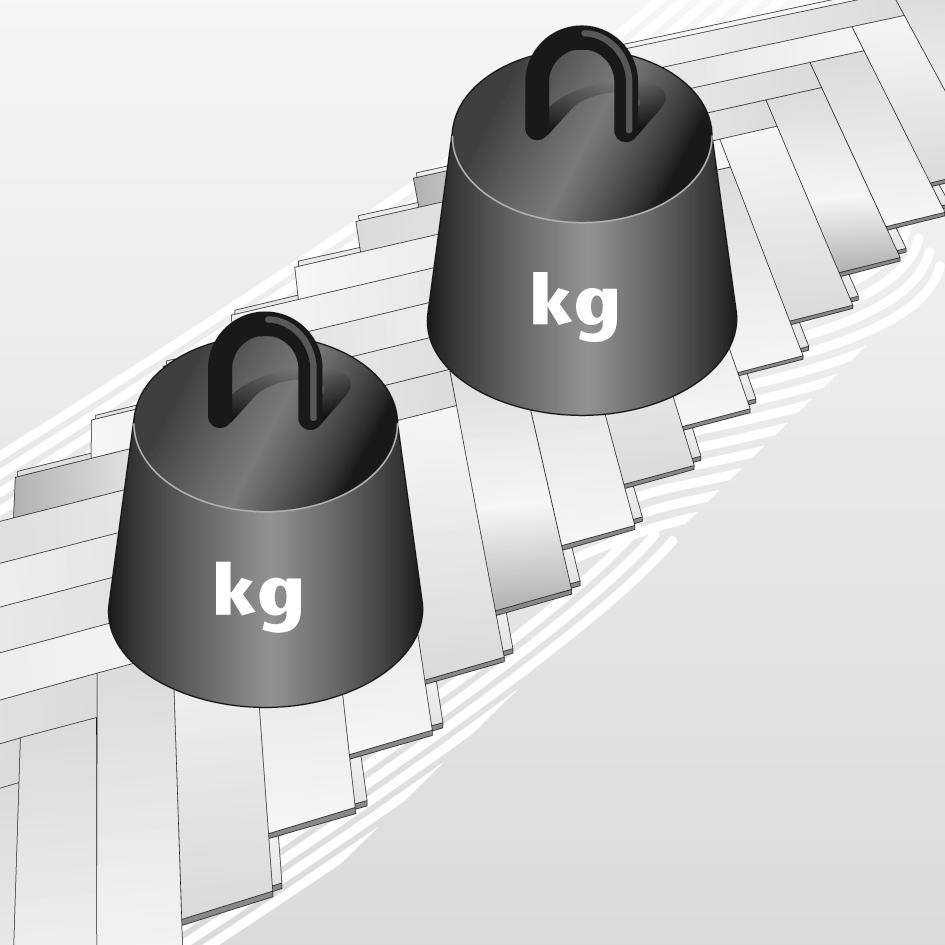
When the starting row has been laid it is recommended to leave the glue to dry over the night, before the floor laying continues. Do not forget to remove excess glue from the floor.
It is advisable to load the floor continuously during laying to ensure a good bond between staves and sub floor. Some contractors use packs of flooring or adhesive containers for this purpose.

When the starting row is dry, you can continue laying the herringbone pattern.
Only apply sufficient glue that the laying of the staves can be finished within 20 minutes.

If the staves are cut at the border or wall so that they are shorter than 100 mm, the tongue and groove joints of the staves must be exceptionally well glued.
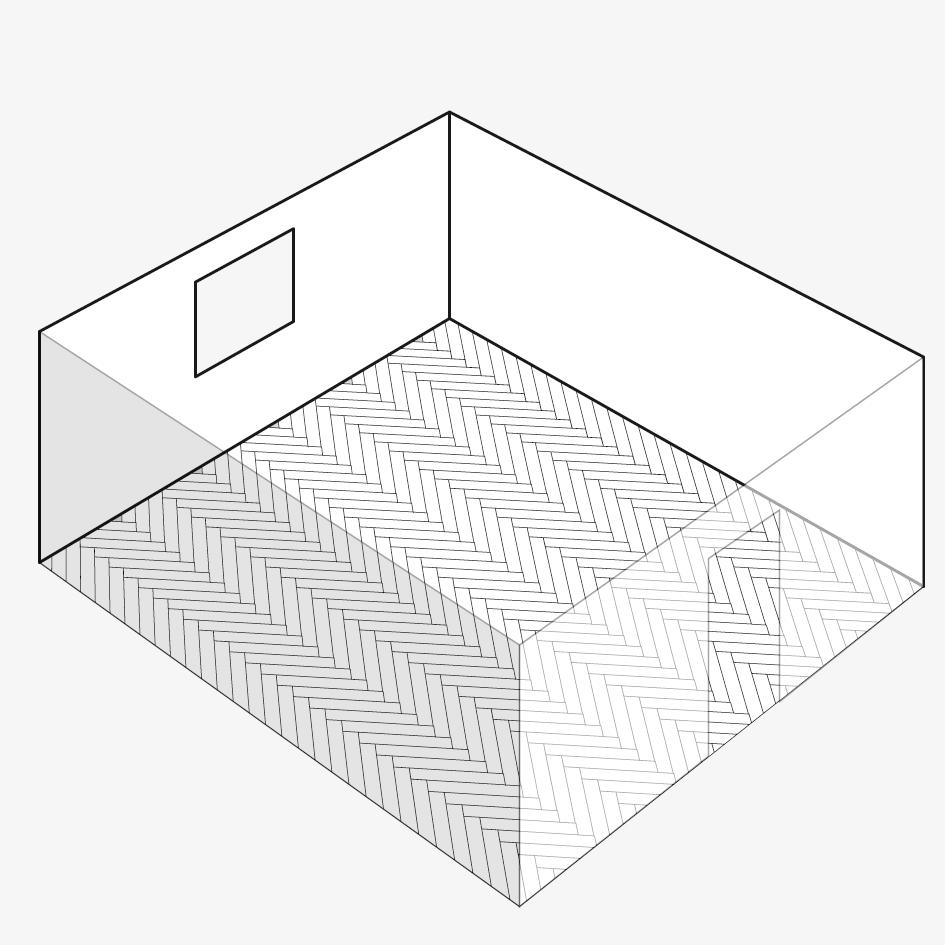
The finished result
Ladder pattern
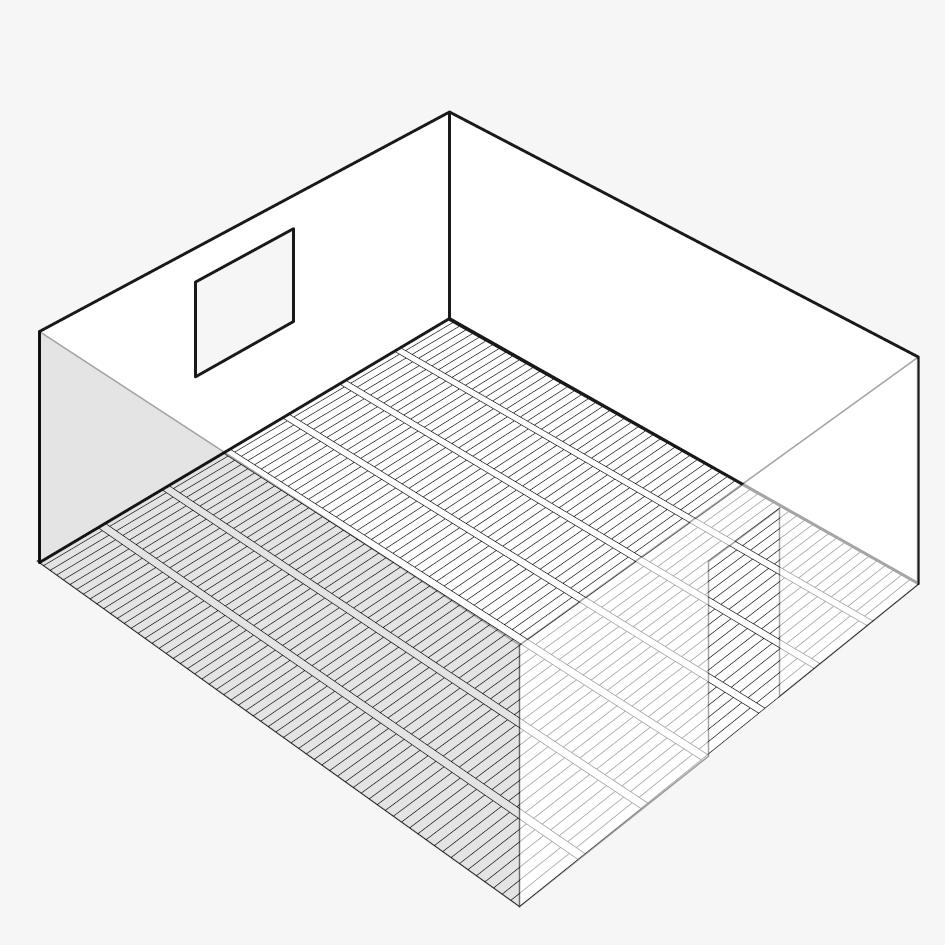
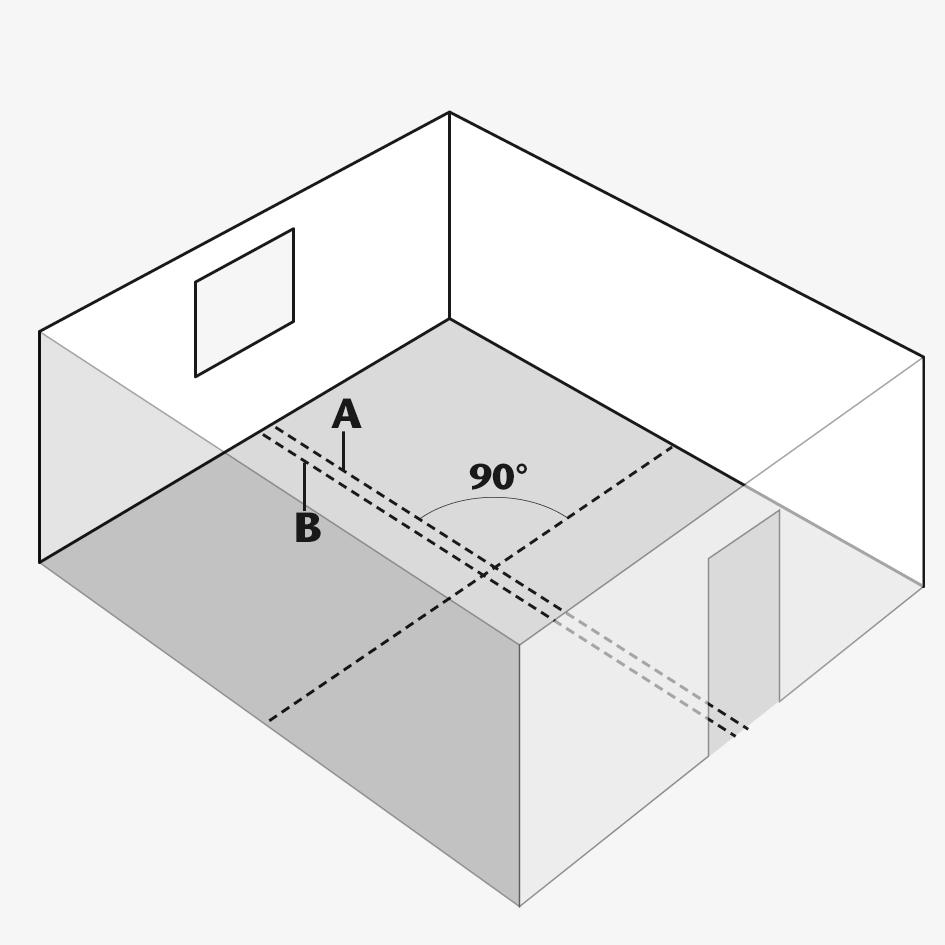
The centre line of the floor is marked by a string or chalk line (line A).
The size of the “cuts” at the walls is measured starting from the centre line. The size of the “cuts” at each side of the room will depend upon the width of the room and if the centre line of the floor passes through a ladder “stringer” or ladder “steps”(shown here starting in the middle of a stringer).
A working line (line B) is drawn half a stave width to the left of the centre line.
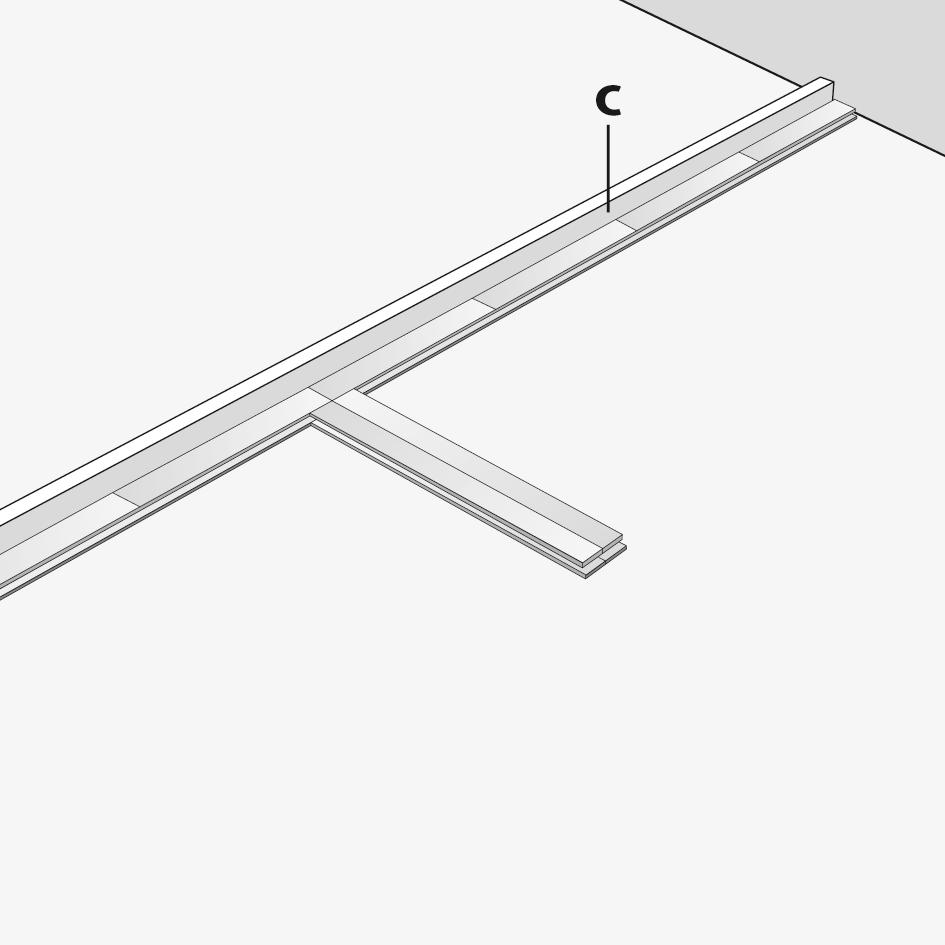
In order to make sure that the first rows of staves do not move during laying, a supporting strip of wood can be screwed temporarily to the subfloor along the working line (line B).
The first stringer (c) in the ladder pattern is glued down along the working line (butted against the supporting strip of wood) to the full length of the room.

The ladder steps are glued down at an angle of 90° to the stringer. It is very important to check that the steps are perpendicular to the stringer in order to achieve a good result.
It is advisable to load the floor continuously during laying to ensure a good bond between staves and sub floor. Some contractors use packs of flooring or adhesive containers for this purpose.

The steps on each side of the stringers must be laid directly opposite each other; you can secure this by marking with a string or chalk line.
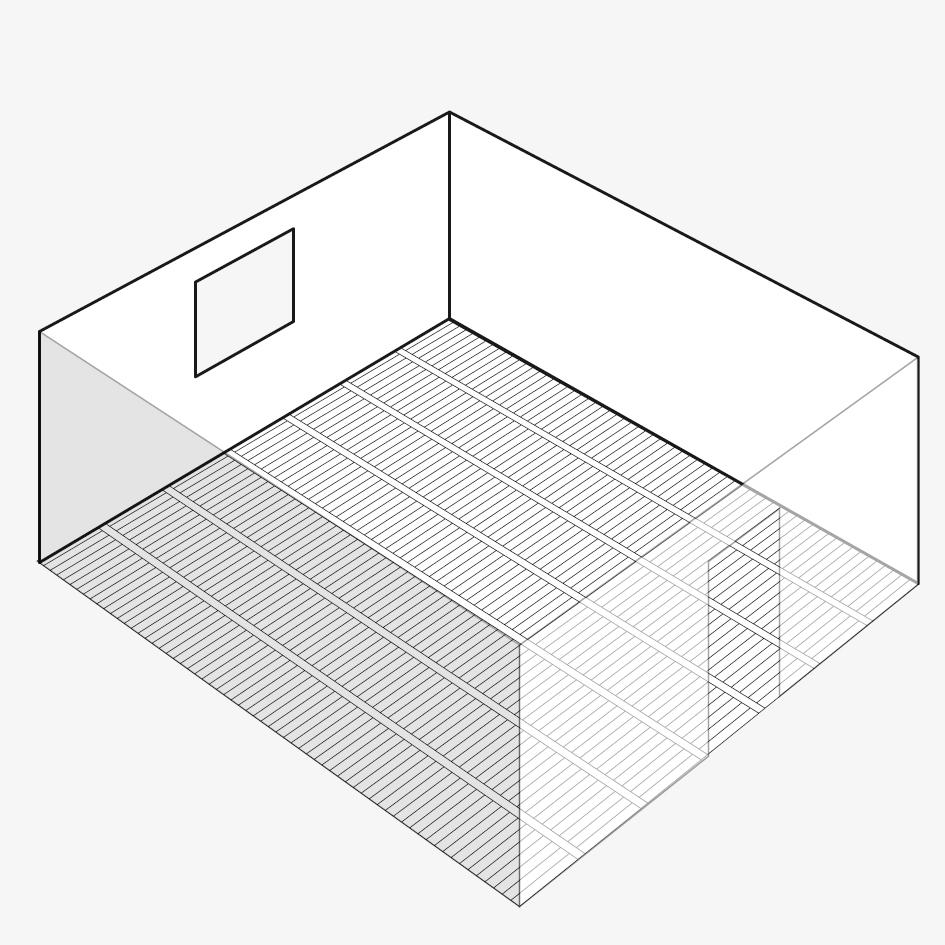
The finished result
SQUARE BASKET PATTERN
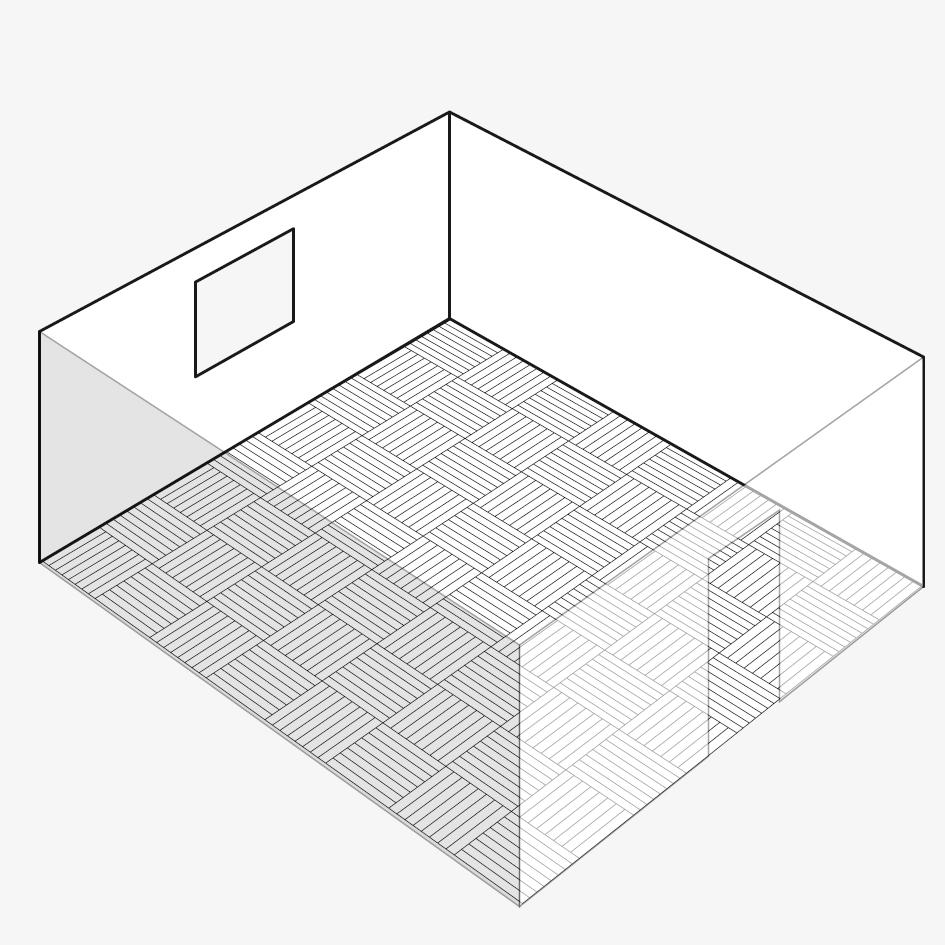

The two centre lines in the room (lines A and B) are marked with a chalk line or string at an angle of 90° to each other.
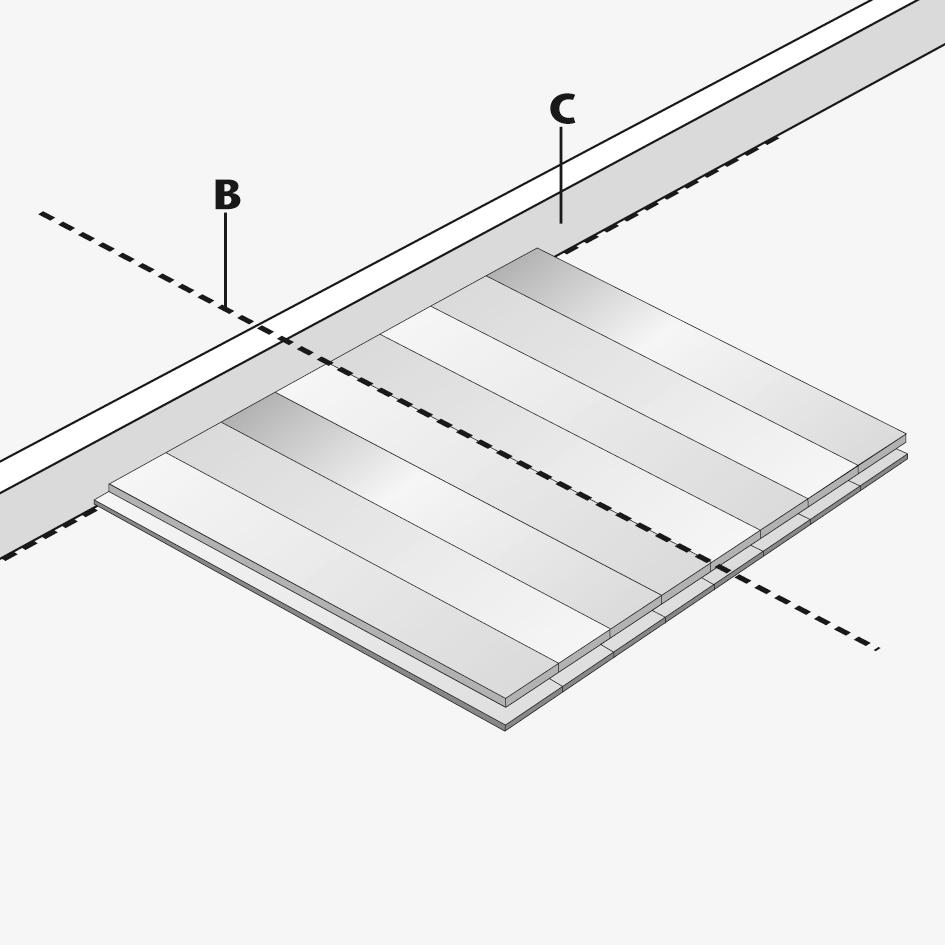
To make sure that the first squares do not move, a supporting strip of wood can be temporarily screwed to the subfloor (C).
The size of the square at the walls is measured starting from the centre line. You can either start with a whole or a half square from the centre line (shown here with a half square from the centre line B).
For best results the part squares at the walls should be larger than a half square.

The staves are glued down in squares laying at an angle of 90° to each other. Alternate right and left staves.
It is advisable to load the floor continuously during laying to ensure a good bond between staves and sub floor. Some contractors use packs of flooring or adhesive containers for this purpose.

The squares are laid through the entire room before the next row of squares is started.

The finished result
The finished result
ENGLISH PATTERN
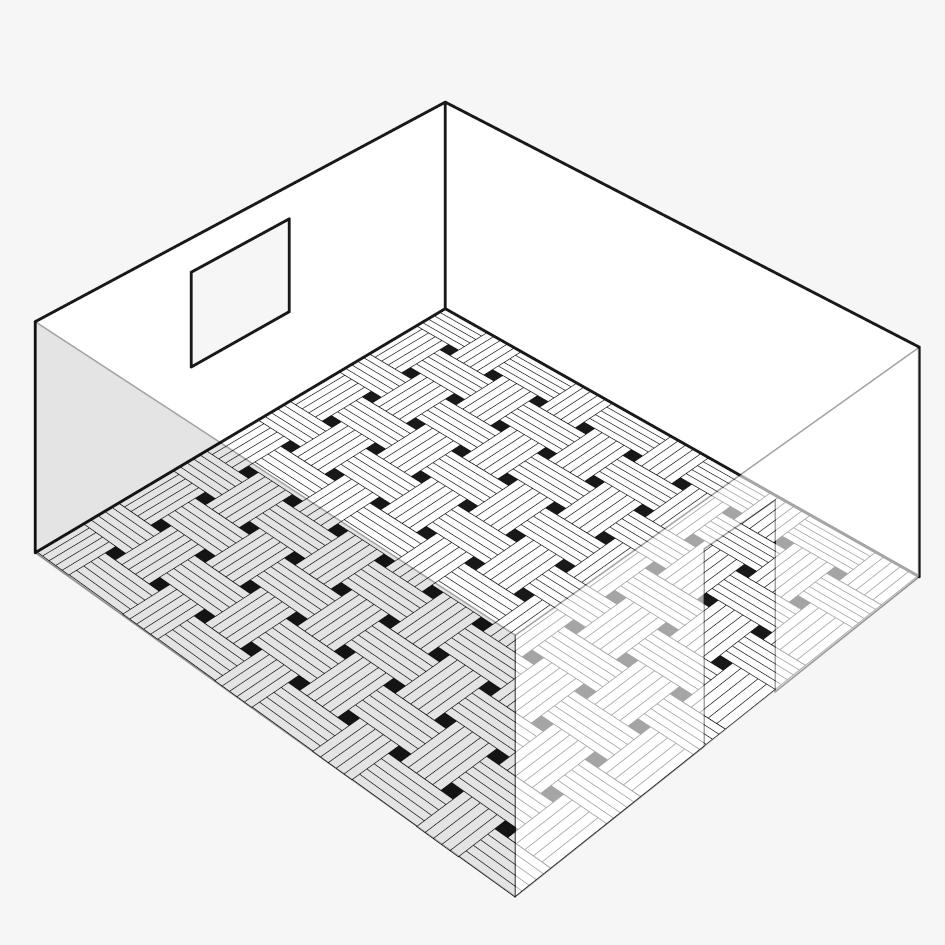
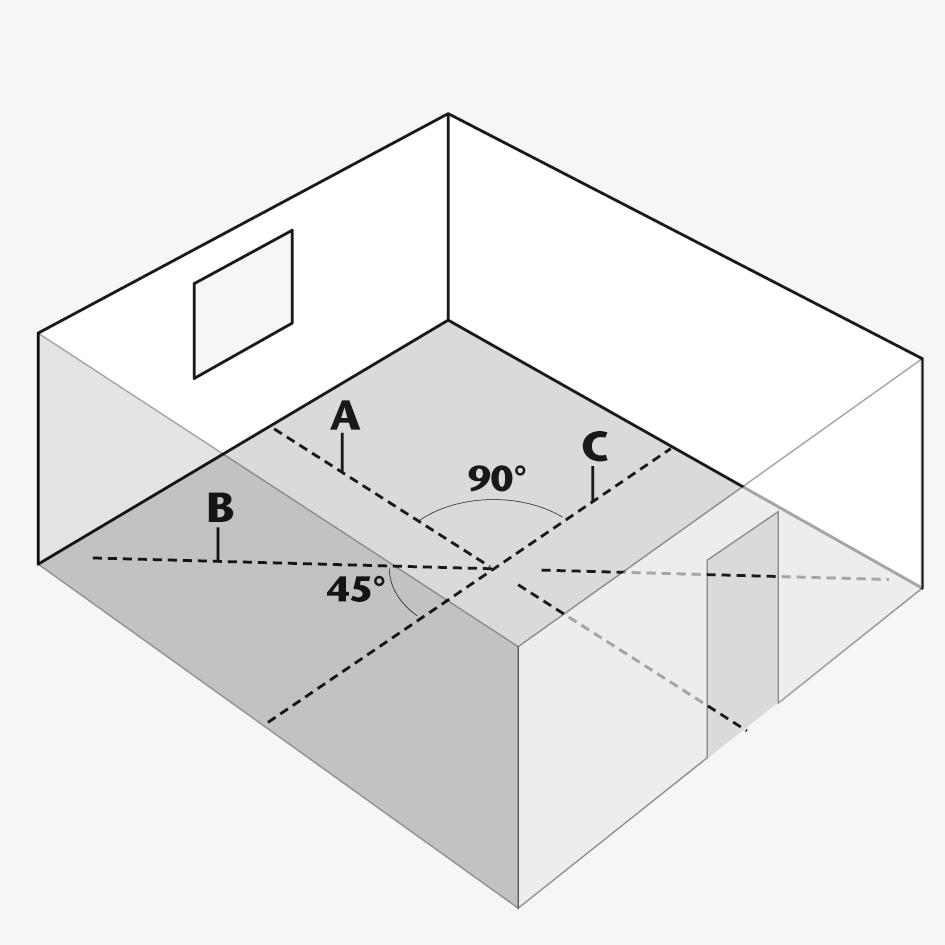
The floor can be laid at an angle of either 90° or 45° in the room (lines A and B, respectively).
The middle of the floor at the two end walls is marked by a string or chalk line (line A or line C).
In the following, the floor is shown laid at an angle of 90°.
The squares consist of 5 staves with 4 insert blocks.
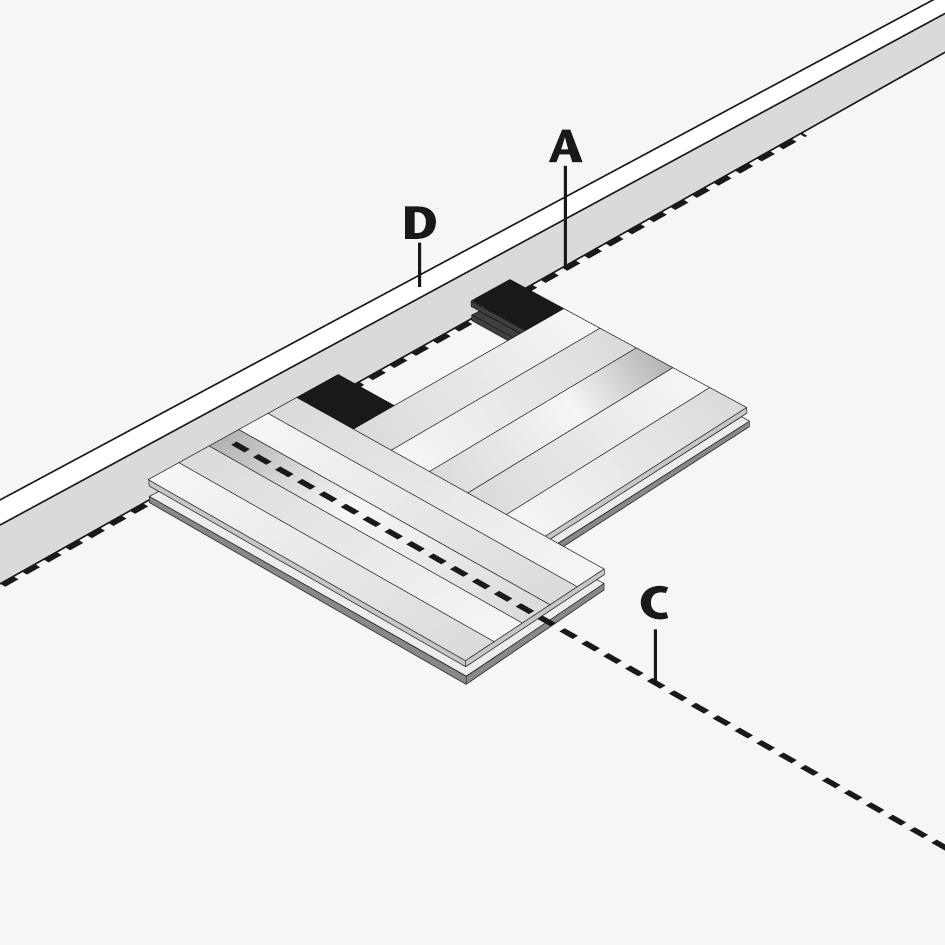
To make sure that the staves do not move, a supporting strip of wood (D) can be temporarily fixed along the working line (line A).
The size of the square at the walls is measured starting from the centre lines. You can either start with a whole or a half square from the centre line (here shown with a half square from the centre line and a whole square from A).
It is important that the staves are laid at an angle of 90° to the working line. Alternative staves of right and left staves.
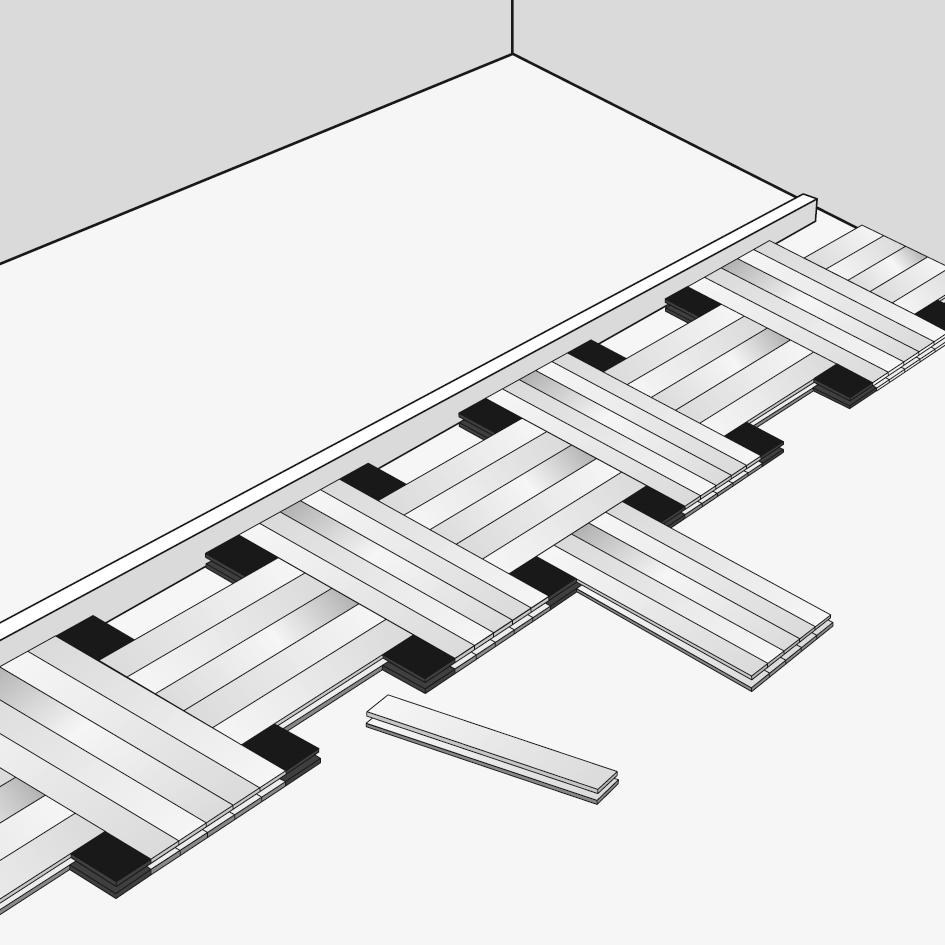
The starting row (the first row of squares with blocks) is laid through the entire room before the next row of squares is started.
During laying it is important to check that the squares are set out accurately.
The pattern blocks are delivered with groove on all sides. Loose tongues are used on sides where the blocks abut the groove side of the staves.
It is advisable to load the floor continuously during laying to ensure a good bond between staves and sub floor. Some contractors use packs of flooring or adhesive containers for this purpose.

The finished result.
FOUR STRIP HERRINGBONE PATTERN
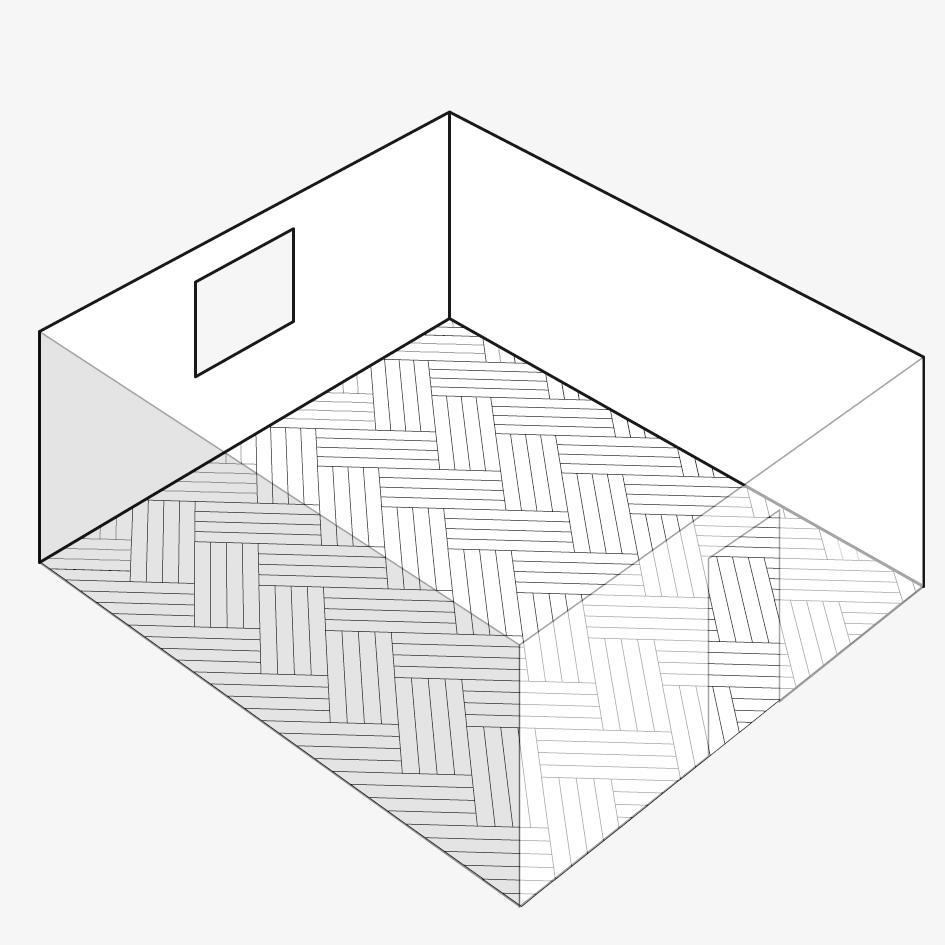
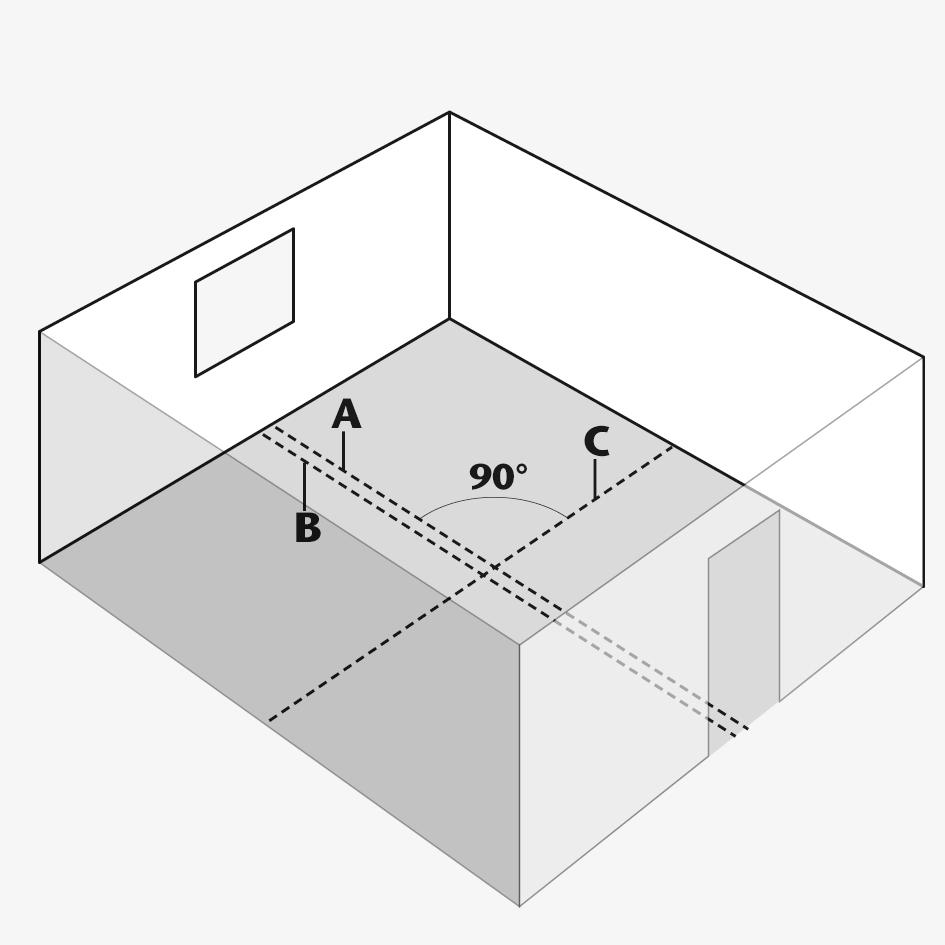
The two centre lines in the room (lines A and C) are marked by a chalk line or string at an angle of 90° to each other.
A working line is drawn by a string or chalk line 82 mm left of the marking (line B).
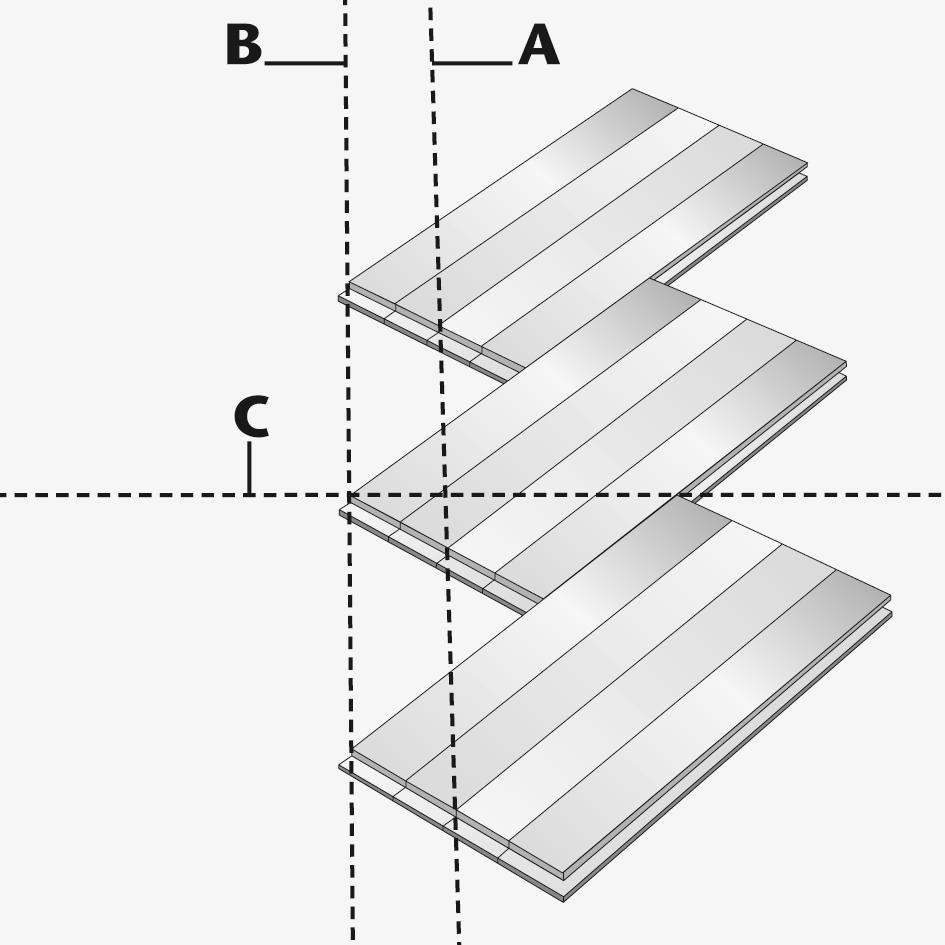
The starting row (the first row in blocks of 4 staves) is laid down through the room. The corners of the staves must be in line with the working line (line B). Particularly at the starting row it is very important that the staves are 100% square. Line C can be used to check the angle by ensuring that the corners be in line with this (see figure).
When the starting row has been laid it is recommended to leave the glue to dry over night, before the floor laying continues. Do not forget to remove excess glue from the floor.
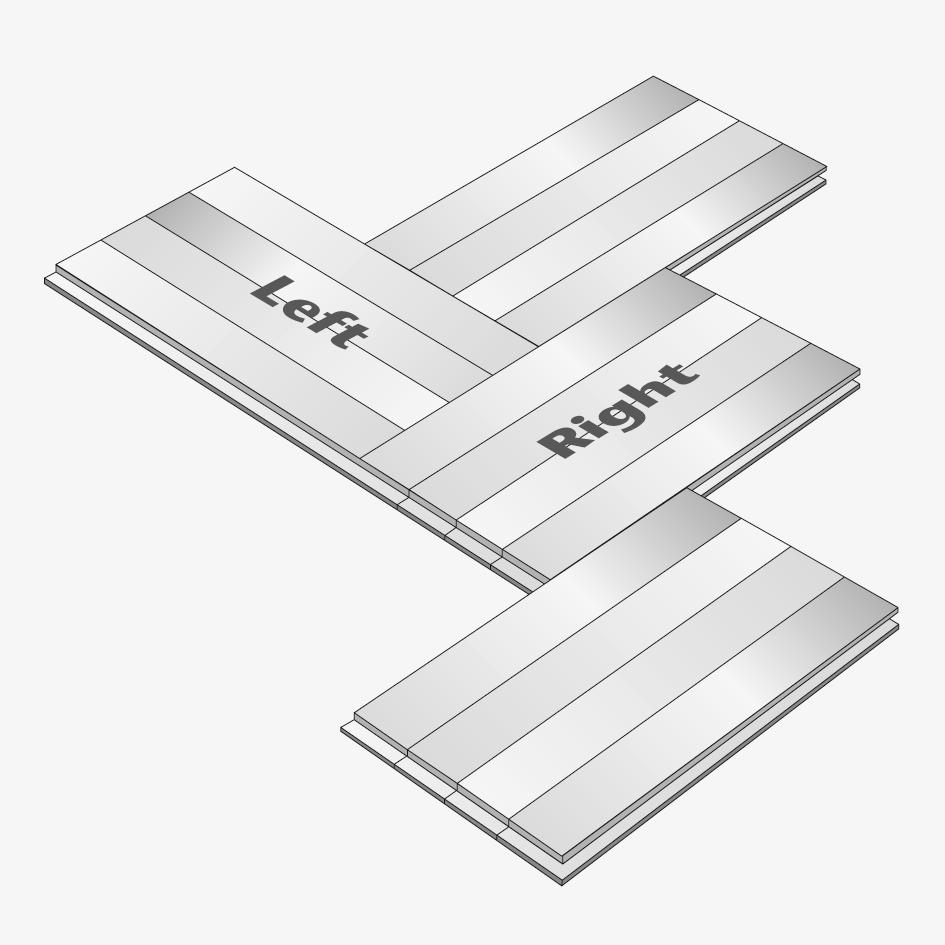
When the glue in the starting row is dry, laying can continue.
The staves are supplied in bundles marked with right and left staves. As the right and left staves are to be laid alternately, it is important to keep the staves separate until the installation begins.
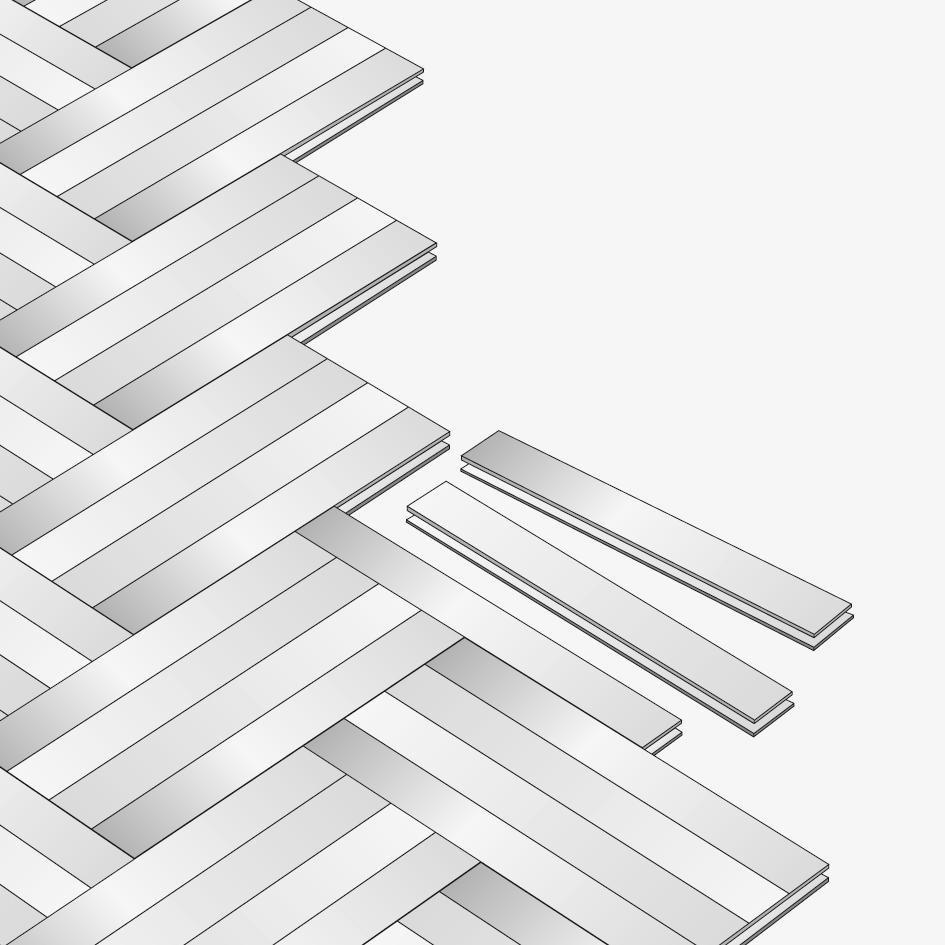
During the laying process it is very important to make sure that the fields with 4 staves are at an angle of 90°.
It is advisable to load the floor continuously during laying to ensure a good bond between staves and sub floor. Some contractors use packs of flooring or adhesive containers for this purpose.

The finished result.
LAYING A BOARDER
The floor can be beautifully framed with a border in the same wood species as the rest of the floor or in another wood species if you want more contrast. The description below is for a floor in herringbone pattern.

If the floor is to be finished with a border at the walls, the floor is cut at the required distance from the wall corresponding to the desired width of the edging, eg 5 x the stave width + distance to the wall.
Example with stave width 58.3 mm where a 5 stave border is required: 5 x 58.3 + 12 mm to the wall = 303.5 mm.

To be able to join the border to the main floor, a groove is cut in the floor edge with a router.
The groove must match the thickness of the tongue of the staves.
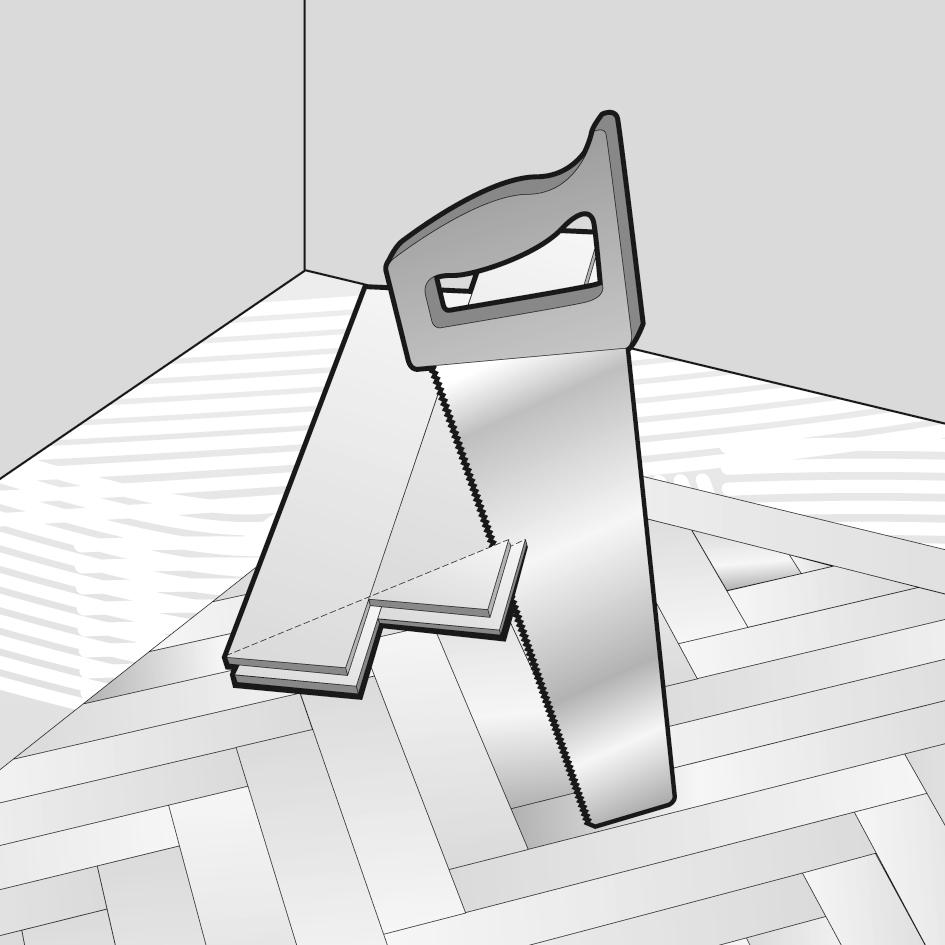
Before being glued down, the border staves are cut to form a mitred corner and a groove is routed in the stave edges to enable a loose tongue to be fitted.

Hereafter the staves are glued down to the edging.
It is advisable to load the floor continuously during laying to ensure a good bond between staves and sub floor. Some contractors use packs of flooring or adhesive containers for this purpose.
Before the skirting is fitted, the floor must be sanded and lacquered/oiled according to the section on surface treatment.
SURFACE TREATMENT OF SOLID SINGLE STAVE BLOCK FLOORS
A beautiful floor requires a strong and durable surface treatment. There are four alternative methods of surface treatment for a floor laid as stave parquet.
1. Lacquer finish
2. Oil finish
3. Oiling + subsequent lacquering
4. Oiling with Junckers Professional Hardwax oil
The choice of surface treatment depends on the desired properties and appearance of the finished floor. See directions for and properties of the various options below.
Sanding
Before the surface treatment is started, the floor is sanded to achieve an even and smooth surface. Finishing sanding must be done with 120 – 150 grit paper or a rorary finishing sander with 120 grit sandpaper. Floors laid in a pattern are first sanded diagonally and then longitudinally in relation to the grain. The entire surface is sanded in the direction from which the light comes. After sanding, the floor is vacuumed thoroughly to remove dirt and dust, etc.
Surface treatment
1. Lacquer finish
A lacquer finish is chosen when a hardwearing surface requiring only a minimum of maintenance is required.
PRIMING OF A LACQUERED FLOOR
Depending on the required properties for the appearance of the floor, there are two alternative types of primer. Both types of primer are to be applied in an even coat with a short haired mohair roller.
A) Junckers PreLak water-based
Fast drying primer to be used if you want less depth of colour to the surface. Apply 1 coat of lacquer and sand at least 2 hours later with grit 120-150 mounted on a polishing machine.

B) Junckers ProSeal oil-based
Slow drying primer to be used if you want to enhance the depth of the colour of the wood. Apply 1 coat of lacquer and sand the next day with 120-150 grit paper mounted on a polishing machine.

Sanding dust is removed by vacuum cleaning and the floor is wiped with a well wrung out cloth.
IMPORTANT!
Make sure that the primer is applied in an even coat from the beginning. The primer must not be poured out but is to be applied in an even coat with a mohair roller. If the primer is poured out, there is a risk of discolouring the wood. Oak is particularly sensitive because of a large content of tannin.
FINISHING TREATMENT OF A LACQUERED FLOOR
Depending on the anticipated traffic level on the floor, there are 2 alternative types of lacquer for finishing the floor. Both types of lacquer must be applied in an even coat using either a brush, a short haired mohair roller, or a lacquer applicator.
A) Residential and other low-traffic areas
After priming, the floor is lacquered with 2 coats of Junckers ProFinish, coverage rate approx. 10 m²/l. Lacquering must take place with an interval of at least 4 hours between coats. Junckers ProFinish is available in 4 different gloss levels: Ultramatt, matt, silk matt or gloss.

B) High-traffic areas
After priming, the floor is lacquered with 2 coats of Junckers HP COMMERCIAL, coverage rate approx. 10-12 m²/l. Lacquering must take place with an interval of at least 4 hours between coats. Junckers HP COMMERCIAL is available in 3 different gloss levels: Ultramatt, matt and silk matt.

2. Oil finish
The oil finish is chosen when you want to enhance the depth of the colour of the wood. An oiled floor must be retreated more frequently than a lacquered floor but, in return, it is possible to carry out partial repairs on the high-wear areas of the floor. This is difficult with lacquer where repairs are typically carried out by lacquering the entire floor.
When using oil, you can choose between clear and coloured oils.
In small areas the oil is applied with a cloth, brush or roller. In larger areas the oil is applied by a roller, mop, or nylon pad mounted on a polishing machine.
Priming of an oiled floor
Priming is carried out with 2 coats of Junckers Rustic Oil clear or coloured to be applied “wet in wet”. Apply the first coat of oil and allow it to soak in for 30 minutes before the second coat is applied, If areas dry out faster, then apply more. Do not allow the surface to dry. After a maximum of 30 minutes, wipe off the excess oil. Dried and unabsorbed oil leaves glossy areas on the surface. The surface should appear matt and even. Large areas should be divided into smaller areas corresponding to an area which can be oiled within 30 minutes. Leave the oil to dry 12-16 hours before the finishing treatment. When using coloured oils, the floor is wiped with a damp cloth before oiling in order to achieve a uniform colour.

Finishing treatment of an oiled floor
Prior to the finishing coats of oil being applied, the primer is screened with a polishing machine mounted with a green or black nylon pad. Sanding dust is removed by vacuum cleaner. Coloured surfaces should be sanded carefully.
Apply a thin coat of Junckers Rustic Oil clear or coloured on the surface according to the absorbency of the wood. Excess oil must be wiped off maximum 30 minutes after application. Polish with a clean cloth until the floor feels dry. Repeat the treatment after 6-8 hours. The floor is ready for use approximately 24 hours after the application of the last coat.
3. Oiling + subsequent lacquering
This solution enhances the depth of the colour of the wood but with the durability and ease of care of lacquer.
PRIMING OF OILED AN OILED FLOOR
Follow the instructions in section 2. Oil finish
It is important that the entire floor is saturated with oil and allowed to dry before the finishing treatment with lacquer. Otherwise there will be a risk of discolouring in connection with the finishing lacquer treatment. Especially oak may need additional oil saturation.
After at least 24 hours the floor is screened with a green nylon pad (do not screen too heavily). Sanding dust is removed by vacuum cleaning and the floor is wiped with a well wrung out cloth.
FINISHING TREATMENT OF AN OILED AND LACQUERED FLOOR
Depending on the anticipated traffic levels on the floor, there are 2 alternative types of lacquer available for finishing the floor. Both types of lacquer are applied in an even coat either by brush, clean short haired mohair roller or lacquer applicator.
A) Residential and other low-traffic areas
After oiling, the floor is lacquered with 2 coats of Junckers ProFinish, 1-component, coverage rate approx. 10 m²/l. Lacquering must take place with an interval of at least 4 hours between coats. Junckers ProFinish is available in 4 different gloss levels: Ultramatt, matt, silk matt or gloss.
B) High-traffic areas
After oiling, the floor is lacquered with 2 coats of Junckers HP COMMERCIAL, 2-component, coverage rate approx. 10-12 m²/l. Lacquering must take place with an interval of at least 4 hours between coats. Junckers HP COMMERCIAL is available in 3 different gloss levels: Ultramatt, matt and silk matt.
After the finishing treatment, the lacquer will have hardened after 72 hours. You can start using the floor carefully after 24 hours.
4. Oiling with Junckers PROFESSIONAL Hardwax Oil
Junckers PROFESSIONAL Hardwax Oil gives a floor solution with a more rich and saturated surface finish. Maintenance is not required as frequently as for traditional oiling but more frequently than for lacquered surfaces.
Apply Junckers PROFESSIONAL Hardwax Oil in an even coat with a roller or brush. After minimum 6 hours another coat of oil is applied and buffing is repeated. If the floor is not saturated after this treatment, it is repeated. Lacquer cannot be applied on top of Junckers PROFESSIONAL Hardwax Oil.
We refer to www.junckers.co.uk/professional/floors/installation for further technical information

